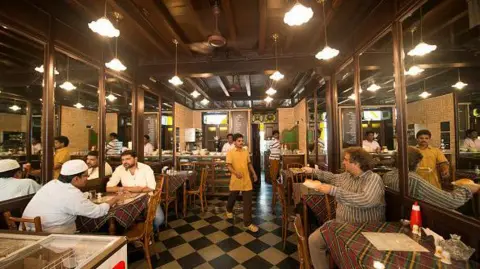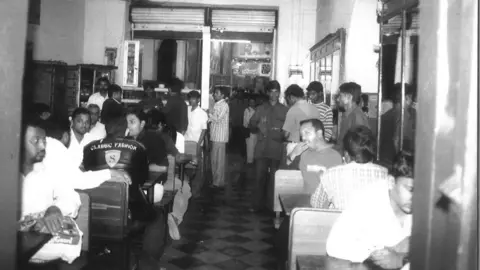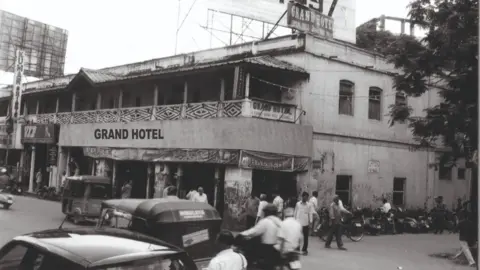
 Getty Images
Getty ImagesA lingering scent of bun maska (bread and butter), plates piled high with freshly baked samosas and cups of hot, creamy Iranian chai.
Here are some of the things that you can usually find in a Persian style cafe in India.
Popularly known as Iranian cafes, these iconic restaurants, with their distinctive marble-topped tables, antique-style clocks, checkerboard floors and distinctive menus, have been a part of Indian culture for over 100 years.
And their influence has extended beyond India’s borders: Dishoom, one of London’s best-known restaurant chains, has taken inspiration from these cafes.
They originated in cities like Mumbai and Pune in the 18th and 19th centuries, when there was an influx of Persian immigrants from Iran.
There is a lesser-known third part of the country, the southern city of Hyderabad, where these cafes have been an integral part of the local culture for decades.
But despite their charm and rich cultural heritage, the city’s cafes, like those in Pune and Mumbai, are on the brink of extinction, with owners blaming rising prices, competition from fast-food restaurants and changing consumer tastes.


Hyderabad has the largest number of Iranian cafes after Mumbai, even today. This is because the city was a center for Iranian trade in the late 19th century.
Persian was widely spoken under the rule of a Muslim Nizam, or prince. The Niloufer café, located in the old quarters of the city, was actually named after the Nizam’s daughter-in-law, an Ottoman princess.
During this period, moreover, some parts of present-day Pakistan still belonged to India, with Iran as its neighbor, which made the country easily accessible to Persian traders.
Most families who moved to Hyderabad – and other Indian cities – did so to escape persecution and famine at home. Some came in search of better jobs and businesses.
Their arrival coincided with the colonial rule, when the British actively promoted tea drinking culture in the country.
When the Iranians arrived, they brought with them their style of tea making, giving rise to a distinct Iranian chai culture in the cities.
In Iran, people drank it without milk, consuming it with a sugar cube in their mouth. Indians, on the other hand, added milk and cream to the tea to give it flavor.
“Initially, the tea was sold under the name Chai Khana and only Muslims drank it,” says historian Mohammed Safiullah of Hyderabad. “But soon, people of all religions discovered its distinctive flavor.”
By the 20th century, Iranian cafes were present in every corner of Hyderabad.
Customers sipped the delicious tea while spending hours chatting in the cafes.
In some bars, customers could also listen to their favorite songs through a jukebox for a small fee.
Historians say these coffeehouses played a crucial role in breaking down social barriers and religious taboos and became an important part of the city’s public life.
“The Iranian coffee houses of Hyderabad became symbols of secularism,” said historian Paravastu Lokeshwar. “Their names had no religious connotations. People of all religions and castes frequented them.”

 Getty Images
Getty ImagesNow they are under threat.
Of the estimated 450 bars that existed more than two decades ago, only 125 remain in Hyderabad today, said Jaleel Farooq Rooz, owner of The Grand Hotel, a popular Iranian bar.
Mr. Rooz’s maternal grandfather arrived from Iran in 1951 and took over the hotel founded by 12 Iranians in 1935.
“We used to sell 8,000-9,000 cups a day. Now we only sell 4,000 a day,” he told the BBC.
He cites competition from fast food chains as one of the reasons. Now one of India’s fastest growing cities, Hyderabad was a sleepy town until the early 1990s. That changed in the mid-1990s, when the city joined India’s IT boom and became an industry powerhouse.
The transformation was accompanied by a series of economic reforms in the country, which allowed global fast food chains and cafes to penetrate the Indian market. Similar to Iranian cafes, these eateries also offered more extensive seating options, but with much better services and more options.


Mr Rooz said that most Iranian cafes operate in rented premises as they need large spaces where customers can relax and unwind while drinking tea.
But rising property prices in Hyderabad have forced many homeowners to change jobs.
“Inflation has also played a role. Prices of tea powder and milk have increased three times compared to five years ago,” he added.
Others argue that the number of Iranian families entering the sector has also decreased.
“The current generation is not interested in the bar and restaurant business. They prefer other jobs and many migrate to other countries,” said the owner of the famous Farasha Restaurant, Mahmood, who uses only one name.
But despite the challenges, there are still some in the industry who continue to go against the grain.
Syed Mohammed Razak runs the Red Rose Restaurant in Hyderabad. His grandfather emigrated from Tehran and founded the City Light Hotel in the 1970s. Mr. Razak’s father later opened the Red Rose Restaurant.

 Getty Images
Getty ImagesAn engineer and graphic designer by profession, Mr Razak admits that “just selling chai and biscuits” is neither easy nor profitable.
She has now introduced new dishes to the menu to attract more customers and is using her graphic design skills to expand her business and promote it online.
“I want to continue my family’s legacy,” he said.
And it’s not just the owners: there are also loyal customers, many of whom have been frequenting these cafes for generations, who say they will always come back for “another cup of Iranian chai.”
“Iranian tea is part of my life, I love the taste of it and I drink it every time I go out,” said Yanni, who goes by just one name and is a regular at the Grand Hotel.
“There is nothing like it even today.”
This article was corrected on July 12, 2024 to clarify that traditional Iranian tea was not prepared with milk or cream.





